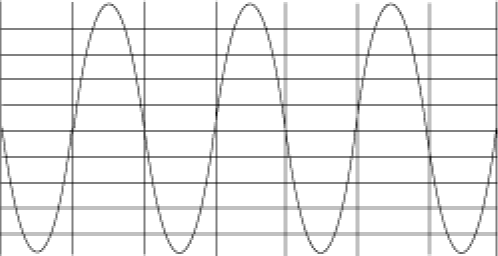Sample Rate
Sample rate is the rate at which a signal is sampled by an ADC. A higher sample rate captures more waveform details while a sample rate that is too low can distort the waveform.
The available sample rates (r) correspond to the following equation:
r = (1.8 MS/s)/y
where y = 1, 2, 3,...1.8 x 105.
Waveform Acquisition Time
The minimum and maximum aperture times for waveform acquisitions are 8.89 µs and 149 s, respectively. To determine if your settings meet the required time, use the following formula:
8.89 µs < n/r < 149 s
where
n equals the number of samples
r equals the rate
 |
Note The available sampling rates are r = (1.8 MS/s)/y, where y = 1, 2, 3,...1.8 x 105. |
For example, if you attempt to acquire two samples at a rate of 1.8 MS/s, the result is:
2/1,800,000 S/s = 1.11 µs
1.11 µs is less than the minimum aperture time, and the driver returns an error. Therefore, you must acquire a minimum of 16 samples at the rate of 1.8 MS/s.
 |
Note The record length corresponds to the aperture time. |
The figure below illustrates a 100 kHz sine wave sampled at 500 kS/s:

The figure below shows the same sine wave sampled at 1.8 MS/s:

The faster rate digitizes 18 points per cycle of the input signal compared with 5 points per cycle with the slower ADC. In this example, the higher sample rate more accurately captures the waveform shape as well as frequency. This process is called over-sampling and can greatly improve the quality of the waveform measurement. The NI 4070/4071/4072 allows for 6 times over-sampling when acquiring a voltage waveform at the limit of its analog bandwidth of 300 kHz or when acquiring a current waveform at the limit of 400 kHz.
When performing a waveform acquisition, select a sampling rate that observes the Nyquist Theorem. Excessive over-sampling has tradeoffs. First, excessive over-sampling may give you more data than you need, unnecessarily consume processor resources, and slow the display. Second, additional noise becomes apparent, because the noise performance of the NI 4070/4071/4072 improves as your sampling rate decreases.
Selecting a sampling rate is typically easy to determine. For example, 44.1 kHz and 48 kHz are standard sample rates for audio signals. The NI 4070/4071/4072 can sample these rates at 45 kS/s and 50 kS/s, respectively, while 24 kS/s is available for low-bandwidth audio applications. Most mid-bandwidth applications, such as audio, can benefit from the use of DC Noise Rejection to reduce noise and improve frequency response.
The NI 4070/4071/4072 can make very-high-resolution low-distortion audio measurements, but it does not have a low-pass filter lower than the bandwidth limitation to provide the alias protection of most audio products. To obtain the flattest response and alias protection with the NI 4070/4071/4072, sample at the maximum rate of 1.8 MS/s and post-process (filter and decimate) in software. You can use the Analysis functions in LabVIEW or CVI to filter the acquired signal.